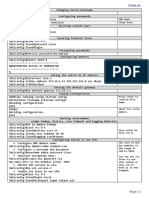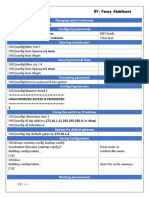0% found this document useful (0 votes)
11 views2 pagesPacket Tracer Command Examples
This document provides examples of commands to configure Cisco Packet Tracer switches, including how to create and assign VLANs, configure trunk and access ports, assign IP addresses to VLANs, enable DHCP and routing, and create port channels.
Uploaded by
ScribdTranslationsCopyright
© © All Rights Reserved
We take content rights seriously. If you suspect this is your content, claim it here.
Available Formats
Download as PDF, TXT or read online on Scribd
0% found this document useful (0 votes)
11 views2 pagesPacket Tracer Command Examples
This document provides examples of commands to configure Cisco Packet Tracer switches, including how to create and assign VLANs, configure trunk and access ports, assign IP addresses to VLANs, enable DHCP and routing, and create port channels.
Uploaded by
ScribdTranslationsCopyright
© © All Rights Reserved
We take content rights seriously. If you suspect this is your content, claim it here.
Available Formats
Download as PDF, TXT or read online on Scribd
/ 2
############################################################
# Examples of commands for Cisco Packet Tracer console #
############################################################
#################################################################
Administrator mode --> enable
#
Configuration mode --> configure terminal
#
#
#
($) --> administrator mode
#
configure terminal mode
#
#
#
# // to cancel a command, put a 'no' in front of the command #
# // view configuration: ($): show running-config #
#################################################################
### Create VLAN on the switch ###
(#): vlan <id number> [Example vlan 2]
name <nombre> [Example name main]
### Assign VLAN to a port ###
(#): interface <portName> [Example interface Fa/01]
switchport access vlan <id number> [ Example switchport access vlan 2 ]
### Put port in trunk mode ###
(#): interface <portName>
switchport trunk encapsulation dot1q
switchport mode trunk
### Add/remove VLAN to the trunk ###
switchport trunk allowed vlan <id number> * To assign
Example: switchport trunk allowed vlan 2
### Assign an IP Address to a VLAN on the switch ###
(#): interface vlan <id number>
(#): ip address <IP> <mask>
### Enable routing on the switch ###
IP routing
### Configure switch to set a DHCP to assign addresses to a VLAN ###
(#): interface vlan <id number>
(#): ip helper-address <dirIP DHCP>
### Configure DHCP to assign addresses ###
in graphic mode
### Configure switch to act as DHCP for a specific VLAN ###
ip dhcp pool <dhcpname> [Example: ip dhcp pool DHCPVLAN20]
(#): default-router <dirIP router> [Example: default-router 158.42.20.1]
(#): dns-server <dirIP DNS> [Example: in our case the dns is the dhcp: dns-server
158.42.2.2
(#): network <starting dirIP> <mask> [Example: network 158.42.20.2] * Yes
start assigning from address 0, exclude the address that should not be assigned
[ip dhcp exclude...]
### Configure the switch routing table to go outside the network ###
ip route <dirIP> <mask> <direction to exit> [Example: ip route
0.0.0.0 0.0.0.0 158.42.2.1
### Create port-channel and assign it to several ports ###
(#): interface <interfaceName> [Example: interface Fa0/1]
(#): channel-group <id> mode on [Example: channel-group 1 mode on]
Now we configure the channel-group to set it to trunk mode
interface port-channel <id> [Example: interface port-channel 1]
Switchport trunk encapsulation dot1q
switchport mode trunk
switchport trunk allowed vlan <id number>
And now we put in the interfaces that interest us the port-channel, in the example
we put it in FastEthernet0/1 and FastEthernet 0/6
(#): interface <interfaceName> [Example: interface Fa0/6]
(#): channel-group <id> mode on [Example: channel-group 1 mode on]
















































































































